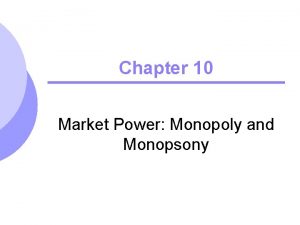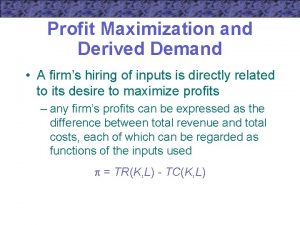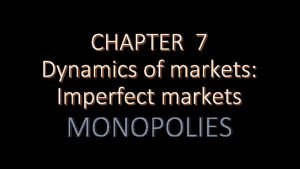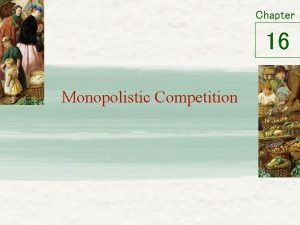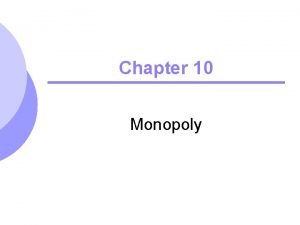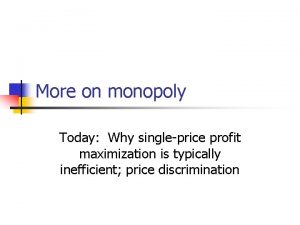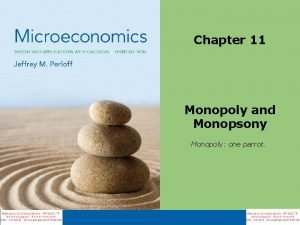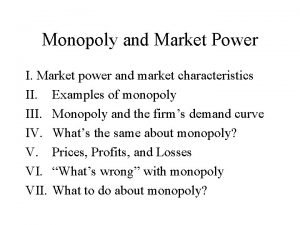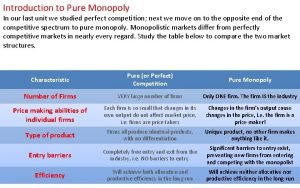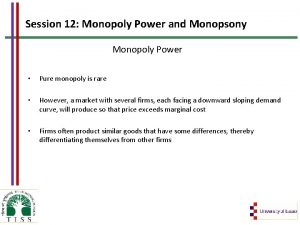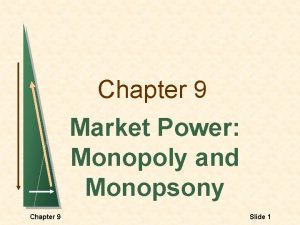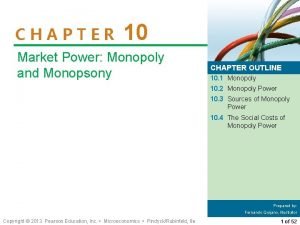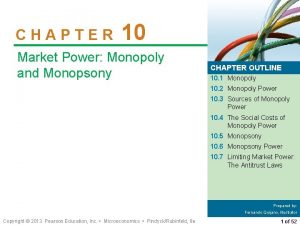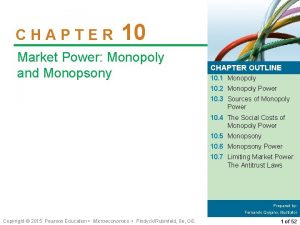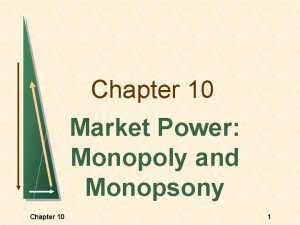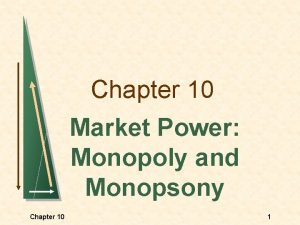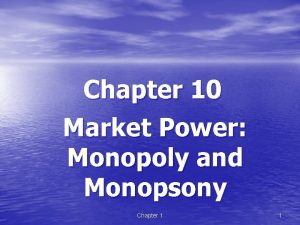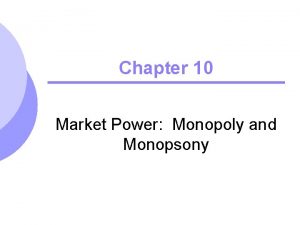Chapter 10 Market Power Monopoly and Monopsony Chapter















- Slides: 15

Chapter 10 Market Power: Monopoly and Monopsony Chapter 10 1

Topics to be Discussed n Monopoly Power n Sources of Monopoly Power n The Social Costs of Monopoly Power n Monopsony Power n Limiting Market Power: The Antitrust Laws Chapter 10 2

Perfect Competition n Review of Perfect Competition l P = LMC = LRAC l Normal profits or zero economic profits in the long run l Large number of buyers and sellers l Homogenous product l Perfect information l Firm is a price taker Chapter 10 3

Perfect Competition Market P D P S Individual Firm LMC P 0 Q 0 Chapter 10 Q LRAC D = MR = P q 0 Q 4

Monopoly n Monopoly 1) One seller - many buyers 2) One product (no good substitutes) 3) Barriers to entry n The monopolist is the supply-side of the market and has complete control over the amount offered for sale. n Profits will be maximized at the level of output where marginal revenue equals marginal cost. Chapter 10 5

Monopoly n n Monopoly pricing compared to perfect competition pricing: l Monopoly P > MC l Perfect Competition P = MC Monopoly pricing compared to perfect competition pricing: l The more elastic the demand the closer price is to marginal cost. l If Ed is a large negative number, price is close to marginal cost and vice versa. Chapter 10 6

Monopoly n The Multiplant Firm l Chapter 10 For many firms, production takes place in two or more different plants whose operating cost can differ. 7

Monopoly Power n Monopoly is rare. n However, a market with several firms, each facing a downward sloping demand curve will produce so that price exceeds marginal cost. n Measuring Monopoly Power l In perfect competition: P = MR = MC l Monopoly power: P > MC Chapter 10 8

Sources of Monopoly Power n Why do some firm’s have considerable monopoly power, and others have little or none? n A firm’s monopoly power is determined by the firm’s elasticity of demand. The firm’s elasticity of demand is determined by: 1) Elasticity of market demand 2) Number of firms 3) The interaction among firms Chapter 10 9

Monopsony n A monopsony is a market in which there is a single buyer. n An oligopsony is a market with only a few buyers. n Monopsony power is the ability of the buyer to affect the price of the good and pay less than the price that would exist in a competitive market. n Competitive Buyer l Price taker l P = Marginal expenditure = Average expenditure l D = Marginal value Chapter 10 10

Competitive Buyer Compared to Competitive Seller Buyer $/Q Seller ME = AE P* MC AR = MR P* ME = MV at Q* ME = P* P* = MV D = MV Q* Chapter 10 MR = MC P* = MR P* = MC Quantity Q* Quantity 11

Monopoly and Monopsony n Monopoly n Monopsony l MR < P l ME > P l P > MC l P < MV l Qm < Q C l Pm > PC l Pm < P C Chapter 10 12

Monopsony Power n A few buyers can influence price (e. g. automobile industry). n Monopsony power gives them the ability to pay a price that is less than marginal value. n The degree of monopsony power depends on three similar factors. 1) Elasticity of market supply u The less elastic the market supply, the greater the monopsony power. 2) Number of buyers u The fewer the number of buyers, the less elastic the supply and the greater the monopsony power. 3) Interaction Among Buyers u The less the buyers compete, the greater the monopsony power. Chapter 10 13

Limiting Market Power: The Antitrust Laws n Antitrust Laws: l Promote a competitive economy l Rules and regulations designed to promote a competitive economy by: u u Chapter 10 Prohibiting actions that restrain or are likely to restrain competition Restricting the forms of market structures that are allowable 14

Summary n Market power is the ability of sellers or buyers to affect the price of a good. n Market power can be in two forms: monopoly power and monopsony power. n Monopoly power is determined in part by the number of firms competing in the market. n Monopsony power is determined in part by the number of buyers in the market. n Sometimes, scale economies make pure monopoly desirable. n We rely on the antitrust laws to prevent firms from obtaining excessive market power. Chapter 10 15
 Monopsony power diagram
Monopsony power diagram Monopsony profit maximization
Monopsony profit maximization Monopsony graph
Monopsony graph Segmentation targeting and positioning
Segmentation targeting and positioning Difference between perfect competition and monopoly market
Difference between perfect competition and monopoly market Difference between monopoly and perfect competition
Difference between monopoly and perfect competition Difference between perfect competition and monopoly
Difference between perfect competition and monopoly Leader follower challenger nicher
Leader follower challenger nicher Xxxyes
Xxxyes Example of monopoly market
Example of monopoly market What is a single price monopoly
What is a single price monopoly Monopoly market examples
Monopoly market examples Characteristic of monopoly
Characteristic of monopoly Monopoly economics
Monopoly economics Features of monopoly market
Features of monopoly market Monopoly market
Monopoly market
